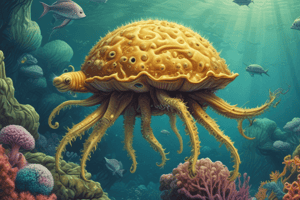Podcast
Questions and Answers
What do all animal cells share in common?
What do all animal cells share in common?
- Exchange materials with their surroundings (correct)
- Inability to reproduce themselves
- Ability to perform photosynthesis
- Ability to synthesize inorganic nutrients
How do daughter cells originate in animals?
How do daughter cells originate in animals?
- By fusion of two different cells
- Through a process of budding
- By forming from spores
- Through multiple divisions of a single cell (fertilized egg) (correct)
What is the initial state of animals at the beginning of their life?
What is the initial state of animals at the beginning of their life?
- Fully developed organisms
- Colonies of cells working together
- Single cell (fertilized egg) (correct)
- Multiple cells with specialized functions
What is the role of homeostasis in animal bodies?
What is the role of homeostasis in animal bodies?
What is the significance of the relationship between structure and function in animal bodies?
What is the significance of the relationship between structure and function in animal bodies?
Animal cells do not exchange materials with their surroundings
Animal cells do not exchange materials with their surroundings
All animal cells obtain energy from organic nutrients
All animal cells obtain energy from organic nutrients
Animals do not detect and respond to signals in their immediate environment
Animals do not detect and respond to signals in their immediate environment
Daughter cells originate from a single cell (fertilized egg) that divides multiple times
Daughter cells originate from a single cell (fertilized egg) that divides multiple times
Homeostasis plays no role in controlling body fluids in animals
Homeostasis plays no role in controlling body fluids in animals
What is the meaning of 'ctenophores'?
What is the meaning of 'ctenophores'?
What is the function of colloblasts in ctenophores?
What is the function of colloblasts in ctenophores?
What is the significance of cilia in ctenophores?
What is the significance of cilia in ctenophores?
What is the unique feature of the gut in ctenophores?
What is the unique feature of the gut in ctenophores?
How are nerve cells arranged in ctenophores?
How are nerve cells arranged in ctenophores?
Flashcards are hidden until you start studying
Study Notes
Common Traits of Animal Cells
- All animal cells share the ability to obtain energy from organic nutrients.
- Animal cells do not exchange materials with their surroundings, maintaining internal environments.
- Unlike some organisms, animals do not detect and respond to immediate environmental signals.
Origin of Daughter Cells in Animals
- Daughter cells originate from a single fertilized egg, which divides multiple times through the process of mitosis.
Initial State of Animals
- Animals begin life as a single fertilized egg, representing an early developmental stage before further differentiation.
Role of Homeostasis in Animal Bodies
- Homeostasis is critical for maintaining stable internal conditions, including body fluids and temperature regulation, despite external changes.
Structure and Function Relationship in Animals
- The relationship between structure and function is significant, as it dictates how various body systems operate efficiently; for instance, the form of organs like the heart contributes to its function in circulation.
Ctenophores Overview
- Ctenophores, also known as comb jellies, are marine invertebrates characterized by their distinctive features.
Function of Colloblasts in Ctenophores
- Colloblasts are specialized cells in ctenophores responsible for capturing prey using sticky secretions, aiding in their feeding strategy.
Significance of Cilia in Ctenophores
- Cilia in ctenophores play a crucial role in locomotion and feeding, allowing them to move through water and transport food to their mouths.
Gut Features in Ctenophores
- Ctenophores possess a unique digestive system with a gut that is branched, providing a larger surface area for nutrient absorption.
Arrangement of Nerve Cells in Ctenophores
- Nerve cells in ctenophores are organized in a decentralized nerve net rather than a centralized brain, enabling coordinated movements and responses.
Studying That Suits You
Use AI to generate personalized quizzes and flashcards to suit your learning preferences.




